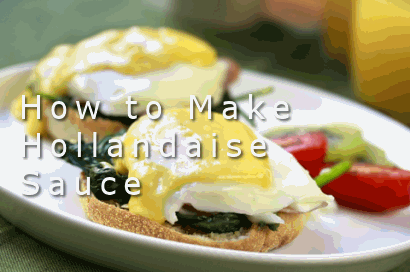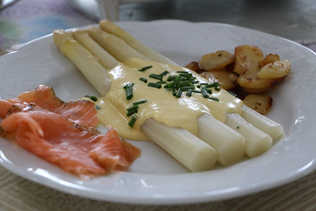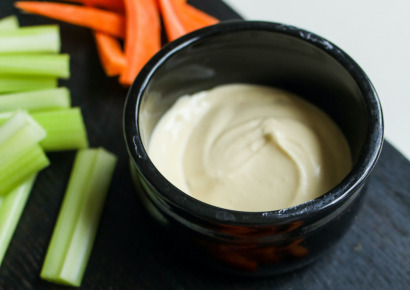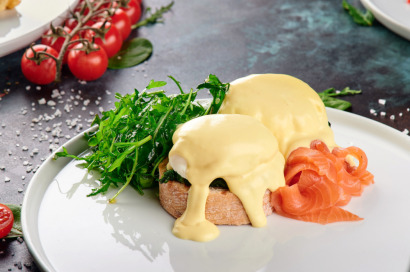Traditional Hollandaise sauce and variations.

Hollandaise sauce is a thick, yellow buttery sauce that is typically associated with Eggs Benedict. Hollandaise sauce is an emulsion, which means that it is a combination of two liquids, in this case lemon juice and butter, that is held together and stabilised by a third agent, egg yolks, to form a rich and thick sauce.
As well as being one of the main components of Eggs Benedict, Hollandaise sauce, is also typically served with steamed asparagus or other vegetables and steamed or grilled fish.
The sauce is a warm and rich yellow in colour and boasts a thick and smooth texture. The end result should be a delicious combination of butter and egg yolks with a tangy twist of lemon and a touch of spice.
As well as being one of the main components of Eggs Benedict, Hollandaise sauce, is also typically served with steamed asparagus or other vegetables and steamed or grilled fish.
The sauce is a warm and rich yellow in colour and boasts a thick and smooth texture. The end result should be a delicious combination of butter and egg yolks with a tangy twist of lemon and a touch of spice.
Advertisements
Although the sauce has few ingredients, it does have a reputation of being very difficult to make. This is because the traditional method involves whisking the lemon juice into the beaten egg yolks, whilst cooking gently over simmering water.
The temperature of the water here is everything, because if there is too much heat, the eggs will scramble and overcook. On the other hand, if the water is not hot enough, the sauce may separate. Therefore this has to be a slow and steady process that cannot be rushed.
The second thing to watch out for is the process of adding the butter (preferably clarified butter). This must be done a little at a time, whilst continuously whisking and if too much butter is added at once, the sauce may not thicken.
Egg yolks can only cope with absorbing a certain amount of butter overall, so if too much butter is incorporated, the sauce will eventually curdle. Try to stick to using no more than 3 oz (85 g) of butter for each egg yolk and this problem should not occur.
Nowadays, the sauce can be partly made in a food processor or blender, which removes some of the difficulties from preparing the sauce and potentially leaves less room for disaster.
Once you have grasped and mastered how to make Hollandaise sauce, you could also try to prepare some of the other sauces that are derived from this French classic.
By adding a handful of capers, a delicious "sauce aux capres" is created, the addition of whipped cream gives "Mousseline Sauce", whilst in order to transform Hollandaise sauce into a delicious "Béarnaise Sauce" to be served with steak, you will need to add a few chopped shallots, some white wine vinegar and a teaspoon of dried tarragon.
Below is a recipe for Hollandaise sauce using the more traditional methods, followed by several recipes including a simple variation..
The temperature of the water here is everything, because if there is too much heat, the eggs will scramble and overcook. On the other hand, if the water is not hot enough, the sauce may separate. Therefore this has to be a slow and steady process that cannot be rushed.
The second thing to watch out for is the process of adding the butter (preferably clarified butter). This must be done a little at a time, whilst continuously whisking and if too much butter is added at once, the sauce may not thicken.
Egg yolks can only cope with absorbing a certain amount of butter overall, so if too much butter is incorporated, the sauce will eventually curdle. Try to stick to using no more than 3 oz (85 g) of butter for each egg yolk and this problem should not occur.
Nowadays, the sauce can be partly made in a food processor or blender, which removes some of the difficulties from preparing the sauce and potentially leaves less room for disaster.
Once you have grasped and mastered how to make Hollandaise sauce, you could also try to prepare some of the other sauces that are derived from this French classic.
By adding a handful of capers, a delicious "sauce aux capres" is created, the addition of whipped cream gives "Mousseline Sauce", whilst in order to transform Hollandaise sauce into a delicious "Béarnaise Sauce" to be served with steak, you will need to add a few chopped shallots, some white wine vinegar and a teaspoon of dried tarragon.
Below is a recipe for Hollandaise sauce using the more traditional methods, followed by several recipes including a simple variation..
Traditional hollandaise sauce
 Traditional hollandaise sauce
Traditional hollandaise sauce
Recipe description
Although this recipe for a traditional hollandaise sauce may seem complicated, our detailed instructions give you a step-by-step easy guide on how to make the sauce. Serve hollandaise sauce with grilled or steamed fish and vegetables or use it in the classic eggs Benedict dish. Serves: 4-5 persons
Prep time: 30 mins
Cooking time: 15 mins
Total time: 45 mins
Ingredients
- 1 1/3 cup of butter
- 2 egg yolks
- 2 tbsp of cold water
- 1 tbsp of lemon juice
- 1 tsp of salt
- pinch of cayenne pepper
Recipe instructions
- Melt the butter in a medium-sized saucepan over a low heat.
- Once the butter has melted, remove the pan from the heat and set aside.
- Taking a spoon, skim off the foam from the surface of the melted butter and discard.
- Transfer the rest of the butter to a warmed pouring jug and set aside.
- Pour 2 inches of water into a saucepan and heat so that the water is gently simmering but not boiling.
- In a glass bowl, whisk the egg yolks with the water until frothy.
- Place the bowl over the pan of simmering water and continue to whisk the egg yolks for several minutes until they have thickened.
- Remove the bowl from the heat and continue to whisk the eggs for a further minute, in order for the eggs to cool down.
- Place the bowl with the eggs back into the saucepan but remove the saucepan from the heat.
- Very slowly, pour the melted butter into the egg yolk mixture, making sure that you continuously whisk the eggs whilst doing so.
- Whisk in the remaining ingredients until they have thoroughly blended together and the sauce is as thick as you require.
- Check the seasoning and then serve immediately or keep warm over a bowl of hot water for up to 30 minutes.
This recipe is for a simple version of this classic French sauce, traditionally served with steamed vegetables, particularly asparagus, eggs Benedict or grilled fish.
This is a recipe for Hollandaise sauce, which is made from egg yolks, butter, lemon juice and cayenne pepper. Enjoy with grilled asparagus or eggs Benedict.
Advertisements
© Copyright 2023 HelpWithCooking.com


